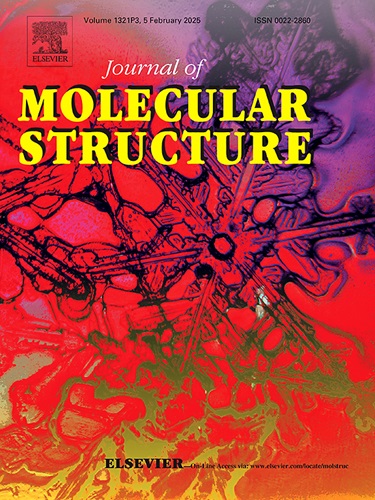Synthesis, in vitro, and in silico evaluation of new carbohydrazide and 1,3,4-oxadiazole linked Bis-indoles as antidiabetic agents
IF 4
2区 化学
Q2 CHEMISTRY, PHYSICAL
引用次数: 0
Abstract
A range of indole-2-carboxylates was successfully prepared via the Hemetsberger reaction using commercially available benzaldehyde derivatives. The indole-2-carboxylates were then converted to the corresponding indole-2-carbohydrazides, which were then reacted with indole-2-carbonyl chloride to generate carbohydrazide-linked bis-indoles. Furthermore, a cyclodehydration reaction of the bis-indole carbohydrazides yielded asymmetrical 1,3,4-oxadiazole-linked bis-indoles. The biological potency of the targeted compounds was evaluated towards the α-glucosidase, α-amylase enzymes and the structure-activity relationship study was also discussed for the determination of new candidates as anti-diabetic agents. The molecules represented higher sensitivity for the inhibition of α-glucosidase enzyme, even better IC50, values were observed than the standard Acarbose, ranging from 69.2 to 251.9 μM. However, α-amylase enzyme was more resistant to synthetized compounds and lower inhibition activity was detected with the collected IC50 data. The presence of oxadiazole ring increased the potency with the maximum interactions, reported as 2D interactions in the molecular docking section, observed on the binding sites of the enzymes and also electron withdrawing substitutions were also helped to obtain the highest potency for both enzyme inhibitions.
新型碳酰肼和1,3,4-恶二唑双吲哚抗糖尿病药物的合成、体外及硅片评价
利用市售苯甲醛衍生物,通过Hemetsberger反应成功制备了一系列吲哚-2-羧酸酯。然后将吲哚-2-羧酸酯转化为相应的吲哚-2-碳酰肼,然后与吲哚-2-羰基氯反应生成碳酰肼连接的双吲哚。此外,双吲哚碳酰肼的环脱水反应产生了不对称的1,3,4-恶二唑连接的双吲哚。对目标化合物进行α-葡萄糖苷酶、α-淀粉酶的生物学效价评价,并探讨其构效关系,以确定新的抗糖尿病药物候选物。该分子对α-葡萄糖苷酶的抑制具有较高的敏感性,IC50值在69.2 ~ 251.9 μM之间,优于标准的阿卡波糖。而α-淀粉酶对合成化合物的抗性更强,IC50数据显示α-淀粉酶的抑制活性较低。恶二唑环的存在增加了药效,最大的相互作用,报道为分子对接部分的二维相互作用,在酶的结合位点上观察到,吸电子取代也有助于获得两种酶抑制的最高效力。
本文章由计算机程序翻译,如有差异,请以英文原文为准。
求助全文
约1分钟内获得全文
求助全文
来源期刊

Journal of Molecular Structure
化学-物理化学
CiteScore
7.10
自引率
15.80%
发文量
2384
审稿时长
45 days
期刊介绍:
The Journal of Molecular Structure is dedicated to the publication of full-length articles and review papers, providing important new structural information on all types of chemical species including:
• Stable and unstable molecules in all types of environments (vapour, molecular beam, liquid, solution, liquid crystal, solid state, matrix-isolated, surface-absorbed etc.)
• Chemical intermediates
• Molecules in excited states
• Biological molecules
• Polymers.
The methods used may include any combination of spectroscopic and non-spectroscopic techniques, for example:
• Infrared spectroscopy (mid, far, near)
• Raman spectroscopy and non-linear Raman methods (CARS, etc.)
• Electronic absorption spectroscopy
• Optical rotatory dispersion and circular dichroism
• Fluorescence and phosphorescence techniques
• Electron spectroscopies (PES, XPS), EXAFS, etc.
• Microwave spectroscopy
• Electron diffraction
• NMR and ESR spectroscopies
• Mössbauer spectroscopy
• X-ray crystallography
• Charge Density Analyses
• Computational Studies (supplementing experimental methods)
We encourage publications combining theoretical and experimental approaches. The structural insights gained by the studies should be correlated with the properties, activity and/ or reactivity of the molecule under investigation and the relevance of this molecule and its implications should be discussed.
 求助内容:
求助内容: 应助结果提醒方式:
应助结果提醒方式:


